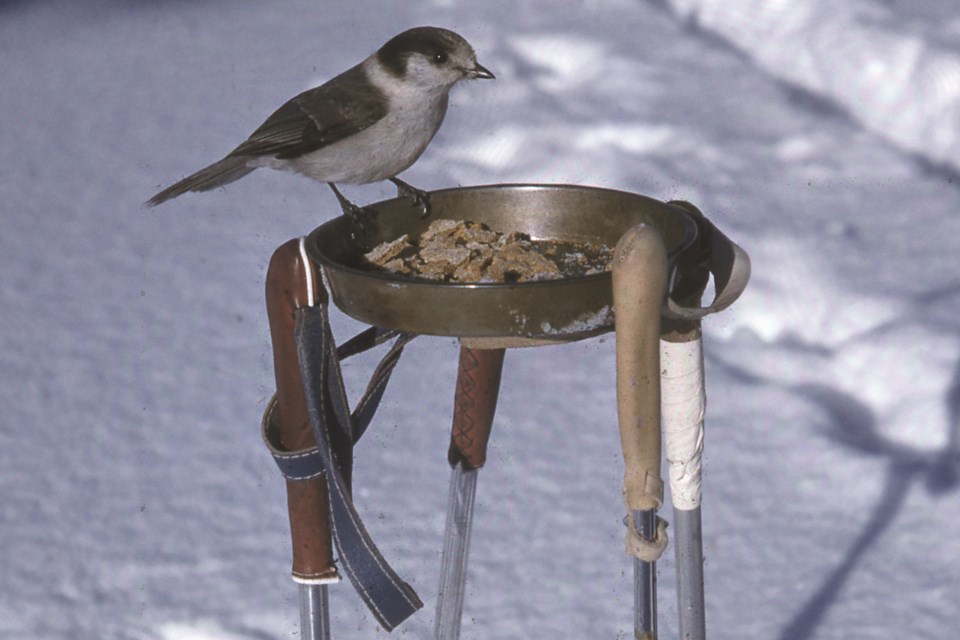While it is easy to point out the changes to Whistler throughout time, one thing that has remained constant on the mountains is the friendly birds up at the top. It is common to hear exclamations of delight in the lift lines of Harmony, Symphony or 7th Heaven as Canada jays fly from ski pole to helmet, looking for an easy lunch.
The Hinterland Who’s Who published by the Canadian Wildlife Service in 1973 phrases it beautifully: “Among birds, the gray jay has intelligence and graces that set it apart. We, who are not accustomed to being approached by any wild creature without fear and anger, are charmed by its easy audacity and prompt to forgive its sins.”
Before lift lines and backcountry campgrounds were the places to be, the Canada jay would join lumber camps, hunters and farmers waiting to “gorge upon warm entrails” of whatever meat was being prepared for dinner. When humans are not butchering the food, Canada jays can do it themselves, catching small mammals, birds, amphibians and insects, and chasing birds from their nests to get the eggs. They are omnivorous and will also feed on berries, needles and buds from trees.
To survive alpine winters, the Canada jay caches food when it is abundant. The food is covered in saliva in the mouth and then the sticky saliva balls are stored in trees for later. One study found that a single Canada jay can store and retrieve thousands of pieces of food annually. However, it is suggested that a warming climate, especially during fall, may cause these perishable food stores to spoil, threatening the reproduction of the Canada jay. One study specifically found that a higher number of freeze-thaw events in fall correlated to fewer and weaker offspring as there was not enough food to both survive and reproduce.
The Canada jay (Perisoreus canadensis) was officially recognised as the gray jay between 1957 and 2018, and is also commonly called the whisky jack. Depending on one’s affection for the sneaky birds they may be known as “camp robber,” “venison hawk” or “grease bird,” alluding to the jay’s fondness for meat and petty thievery. To prevent confusion stemming from multiple common names, scientific binomial names assign each species a unique two-word identifier so they can be recognised globally. The first word being the genus name (Perisoreus) and the second is the species name (canadensis).
Until recently it was thought that birds could only change their feather colour when they moult. Adding to confusion while classifying and identifying this species, the Canada jay appears to be an exception to this rule, becoming browner throughout the year until they moult back to a fresh grey coat in Maya/June. It also appears that preserved specimens may continue to lose their grey colour, becoming browner throughout time in museum collections. This colour change tricked taxonomists into originally identifying Canada jays as multiple species.
The 1941 Field Guide to Western Birds in the museum library contains separate descriptions of the Canada jay (Perisoreus canadensis) and Oregon jay (Perisoreus obscurus). With advances in identification and classification, including DNA technology, we now know they are a single species. Luckily, Margaret Mackenzie, the owner of the field guide, had ticked them both off as identified anyway.
Regardless of what you call them, the love for these birds is widespread. “Trusting and easily tamed, the gray jay is good company for men in lonely places,” reads the Hinterland Who’s Who.
They just do not write governmental scientific publications like they used to.


.jpg;w=120;h=80;mode=crop)

